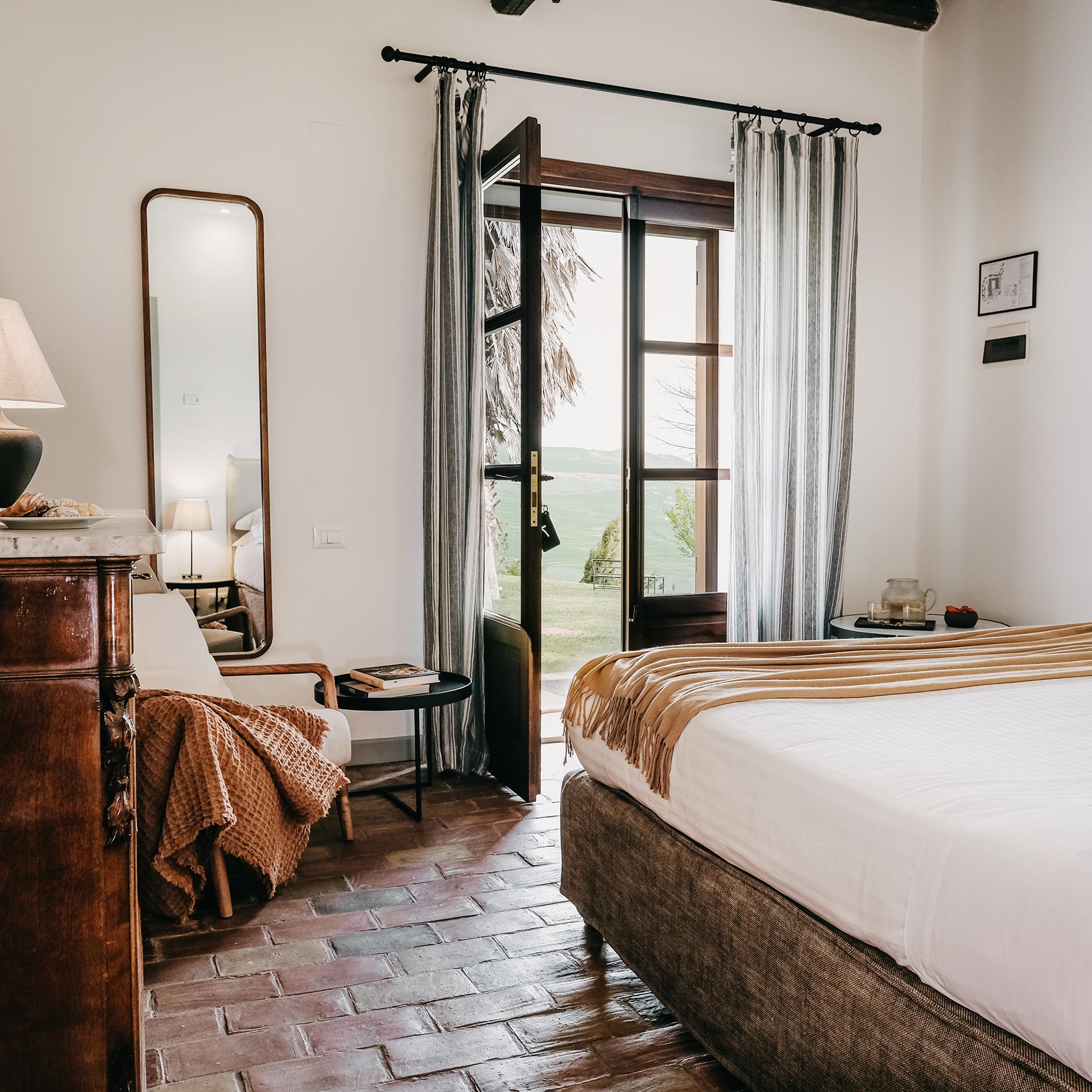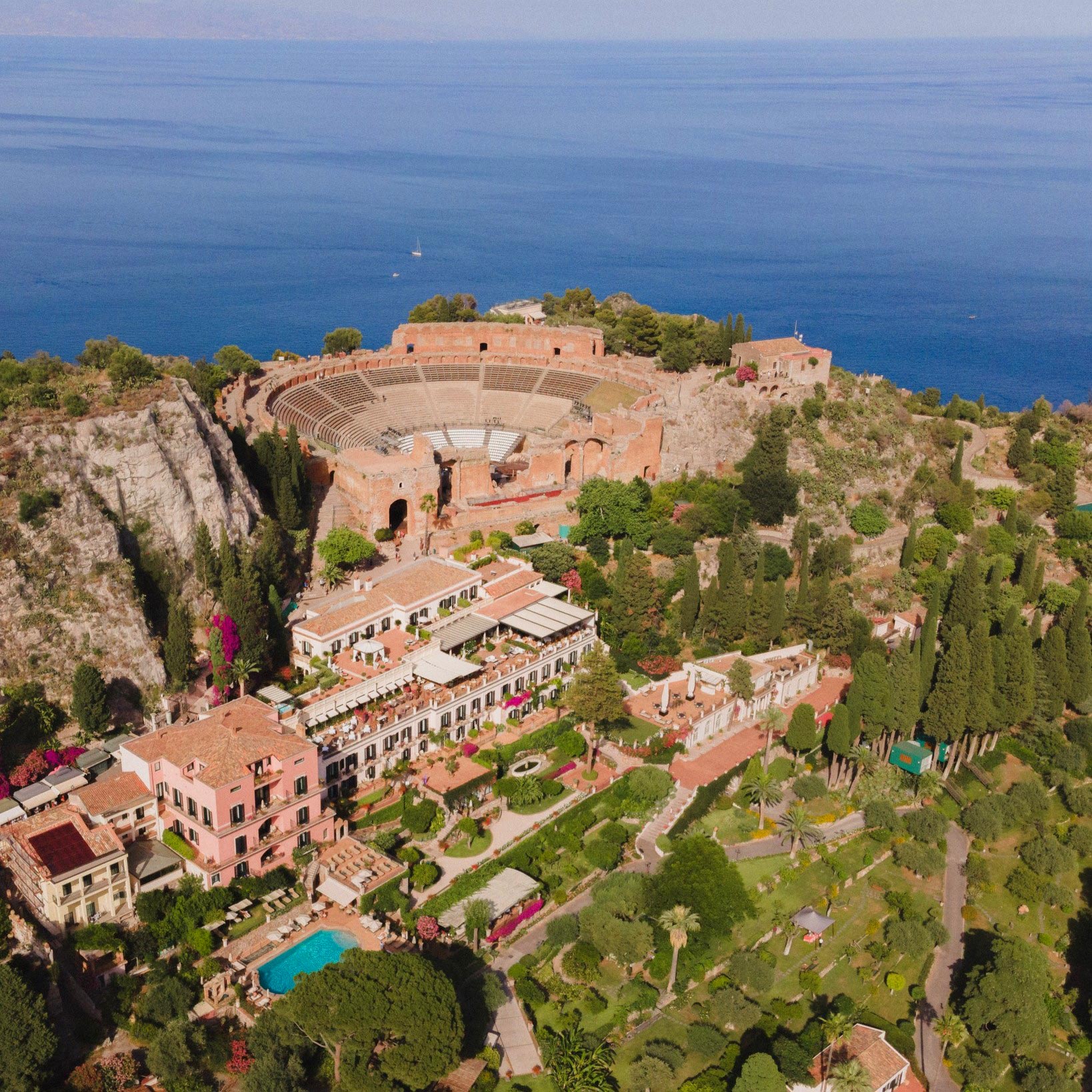
Sicily isn’t exactly off the beaten path, but it hasn’t always been part of the standard Italian itinerary. That’s changing as visitors discover the island via Italy’s most cherished mode of travel.
By Mark Fedeli
Marketing and Editorial Director, Tablet Hotels
“To have seen Italy without having seen Sicily is to not have seen Italy at all, for Sicily is the clue to everything.” — J. W. Goethe, 1817
Two hundred years ago, Goethe put his finger on something many travelers have recently come to realize. It can feel like everyone goes to Rome or Tuscany or Amalfi or the Alps; a trip around Sicily is a less obvious way to indulge your Italian fantasies without missing out on the core offerings the country is famous for. And we do mean around. Consider experiencing Sicily by car, road-trip style. All told, the island loop traverses just over 750 kilometers, bringing you through volcanic countryside and along the iconic coastline.
Driving in Sicily is many things: an art, a habit, a game, a challenge. Signage can be more suggestive than informative, and it won’t always be clear at first glance which route is best. That’s all part of the fun. Most importantly, plan on a leisurely pace, lingering at each stopping point and scheduling your hotel arrivals in time to appreciate the sunsets.
About those hotels. We’ve listed some of our most notable accommodations down below, but you can see our entire selection here. You’ll notice a similar range of styles to what you’ll find on the mainland, just more manageable in number. There is a healthy dose of rustic farm hotels (the legendary agriturismo and masseria), sea-facing clifftop luxury resorts, and art-centric design-forward boutique inns.

Back to the road. Along the coastal route you’ll trundle past at least a few Torri costiere della Sicilia, the 218 ancient watchtowers that ring the island. These date back to 14th-century Aragonese rule and served to defend against incursion by pirates and other seafaring invaders. Another indelible symbol of the region? The coppola, a tweed driving cap popularized in the early 20th century. You’d look great in one as you enjoy more of Sicily’s spectacular archaeological bounty:
• Taormina’s Teatro Antico, a horseshoe-shaped theatre that hosts arts festivals in season.
• In Syracuse, the Parco Archeologico della Neapolis and its bizarre, catacombed limestone quarry.
• The Eastern Zone of the Valley of the Temples just south of Agrigento.
• The ruins of once-mighty Selinunte on the southwest shore outside Sciacca.
And then of course, Mt. Etna, one of the world’s most active volcanoes and Europe’s tallest. Fun fact: Mt. Etna is second only to the South Pole in terms of geopolitical complexity: ten municipalities converge to one point at its summit.
Obviously we recommend choosing your route based on the hotels you most want to sleep in. In proper road-trip form, the list below starts with hotels just south of Catania, which has Sicily’s main airport, and heads clockwise all the way around the island, providing options both right along the water and further inland in the countryside.
In terms of which car you should rent, anything other than a vintage convertible would be sacrilegious. Now hit the road!
Lùme
Siracusa, Italy
Ortigia, the historic heart of the city of Siracusa, is the setting for Lùme, a six-bedroom boutique bed and breakfast owned by a Parisian hotelier that showcases this Italian city in as flattering a light as anything by a local. At this size, you get the expected warmth and intimacy of a private home; what’s more remarkable is to combine that feeling with the sophisticated stylishness that’s on display at Lùme.
Dimora delle Balze
Noto, Italy
Behind the stone walls old this farming estate, a half-hour inland from Syracuse, is Dimora delle Balze, an eleven-room masseria decorated in that inimitably Italian fashion, with the ancient and the modern existing happily side by side. Modernist furnishings and rustic, well-worn architecture create plenty of visual interest, and the tension is resolved by the sheer comfort of the guest rooms.
Country House Villadorata
Noto, Italy
Nestled in the heart of the Val di Noto — a UNESCO World Heritage Site and the cradle of Sicilian Baroque — Country House Villadorata is the result of the restoration of a late 19th-century rural estate. Today, it stands as an elegant eco-resort surrounded by 57 acres of countryside, cultivated in harmony with the principles of biodynamic agriculture. The landscape is defined by ancient olive trees, almond groves, orchards, and a small vineyard.
A.D. 1768 Boutique Hotel
Ragusa, Italy
In Ragusa’s historic quarter of Ragusa Ibla, there’s a seemingly limitless supply of 18th-century Baroque architecture, and a.d. 1768 Boutique Hotel, named for the year of its construction, is a prime example. Even in such rich surroundings, it stands out, with a privileged position alongside the cathedral and the Piazza Duomo. But for all of the history, its proprietors are not shy about incorporating modern and contemporary influences.
Eremo della Giubiliana
Ragusa, Italy
Near the south coast of Sicily, housed in a medieval-era convent once occupied by the Knights of Malta, lies the Eremo della Giubiliana, a remarkably posh boutique hotel hidden away within an imposing fortified exterior. These stone walls still look up to the task of repelling an invading force, but inside it’s elegant and sophisticated in a way that one doesn’t often expect from rustic, rugged Sicily.
Villa Athena Resort
Agrigento, Italy
You won’t find a hotel richer in grand monuments and architectural remnants than Sicily’s Villa Athena Resort. Set within the Valley of the Temples, a designated archaeological park, and originally an opulent 18th century private residence, Villa Athena is an ancient stone’s throw away from the 5th-century B.C. Temple of Concordia, as well as many other legendary treasures. Call it archaeology-by-bedroom-window.
La Foresteria Planeta Estate
Contrada Passo di Gurra, Italy
Sicily’s Planeta family is perhaps best known for the wines and olive oils that they produce, but with La Foresteria Planeta Estate they turn their hand to hospitality, with impressive results. Here, in the remote far west of Sicily, they’ve created a small-scale country retreat, a contemporary 14-room luxury hotel overlooking the vineyards and olive groves of one of this island’s most gently scenic regions.
Cave Bianche Hotel
Favignana, Italy
Calcarenite is a type of sedimentary rock. This fact is important to know because Cave Bianche Hotel is housed in a large calcarenite quarry on the island of Favignana, immediately off the far western coast of Sicily. Cave Bianche says they’re the first hotel in the world to be built in a quarry, and we have no reason not to believe them. If that’s not enough, there’s a large swimming pool and you’re never far from beaches and grottos along the Mediterranean.
Marina di Petrolo Hotel & Spa
Castellammare del Golfo, Italy
Sometimes all it takes is a special location and a hotelier who knows how to handle the basics. The setting of Marina di Petrolo, an hour’s drive to the west of Palermo, overlooking the Gulf of Castellammare, is stunning. And we do mean overlooking, as the hotel itself sits in an elevated position right above the water, with many of its rooms facing directly out to sea or down the coast.
Villa Igiea
Palermo, Italy
Designed by architect Ernesto Basile for the Florio family, Villa Igiea is a stunning Art Nouveau masterpiece that recently underwent a massive refurbishment care of Rocco Forte Hotels. Guests are welcomed into luxurious surroundings, including terraced gardens with sea views, Belle Époque halls, period furnishings, and frescoes. Originally intended as a sanatorium, the building has long been one of Italy’s most luxurious hotels.
Susafa
Polizzi Generosa, Italy
Tough as the local competition may be, Susafa still manages to stand out. A working farm in Sicily’s rustic, hilly interior, this country boutique hotel distills centuries of hospitality and husbandry into a charming, restful bullseye — it’s commanded the verdant countryside for five generations under the stewardship of the Saeli-Rizzuto family. In fact, the 17 guestrooms retain their original ceiling beams and antique tiles.
Le Calette
Cefalù, Italy
While completing a project near the fishing village of Cefalù in the late 1960s, a Sicilian engineer fell in love with the green hills of the island’s rugged northern shore. He bought a piece of land to build his dream house, and half a century later, it’s still in the family — now in the form of a charming boutique hotel, Le Calette. The name refers to the wildly beautiful setting overlooking the coastline’s craggy coves.
Belmond Grand Hotel Timeo
Taormina, Italy
Nestled beside the Greek Theatre and offering a unique view of the sea and Mount Etna, the Belmond Grand Hotel Timeo has stood as an opulent symbol of Sicilian aristocracy since 1873. It has welcomed guests such as Oscar Wilde, D. H. Lawrence, Guy de Maupassant, and Kaiser Wilhelm II — all undoubtedly captivated by the sublime views and the grandeur of the Timeo’s interiors, adorned with Sicilian Baroque flourishes.
Castello di San Marco Charming Hotel
Calatabiano, Italy
Sicily is supposed to be wild and untamed, but Castello di San Marco proves Tuscany’s got no monopoly on the genteel, aristocratic life. Here, in the shadow of Etna, between Taormina and Catania, you may as well be in a different world, and here, you’ll find a hotel that combines a typically Italian obsession with food, wine and the good life with a very local — and quite unusual — Sicilian Baroque atmosphere.
DonnaCarmela Resort & Lodges
Carruba, Italy
In English, the word “typical” is reserved for things that are ordinary, unremarkable, anything but special. But in Romance languages, it’s more or less the opposite; to call a Sicilian hotel “typical” is to say that it’s an emblem of everything that’s unique to Sicily, and it’s in that sense that DonnaCarmela Resort & Lodges is typical of its setting — as you’ll see, it’s far from ordinary.

Mark Fedeli is the hotel marketing and editorial director for Tablet and Michelin Guide. He’s been with Tablet since 2006, and he thinks you should subscribe to our newsletter.

















